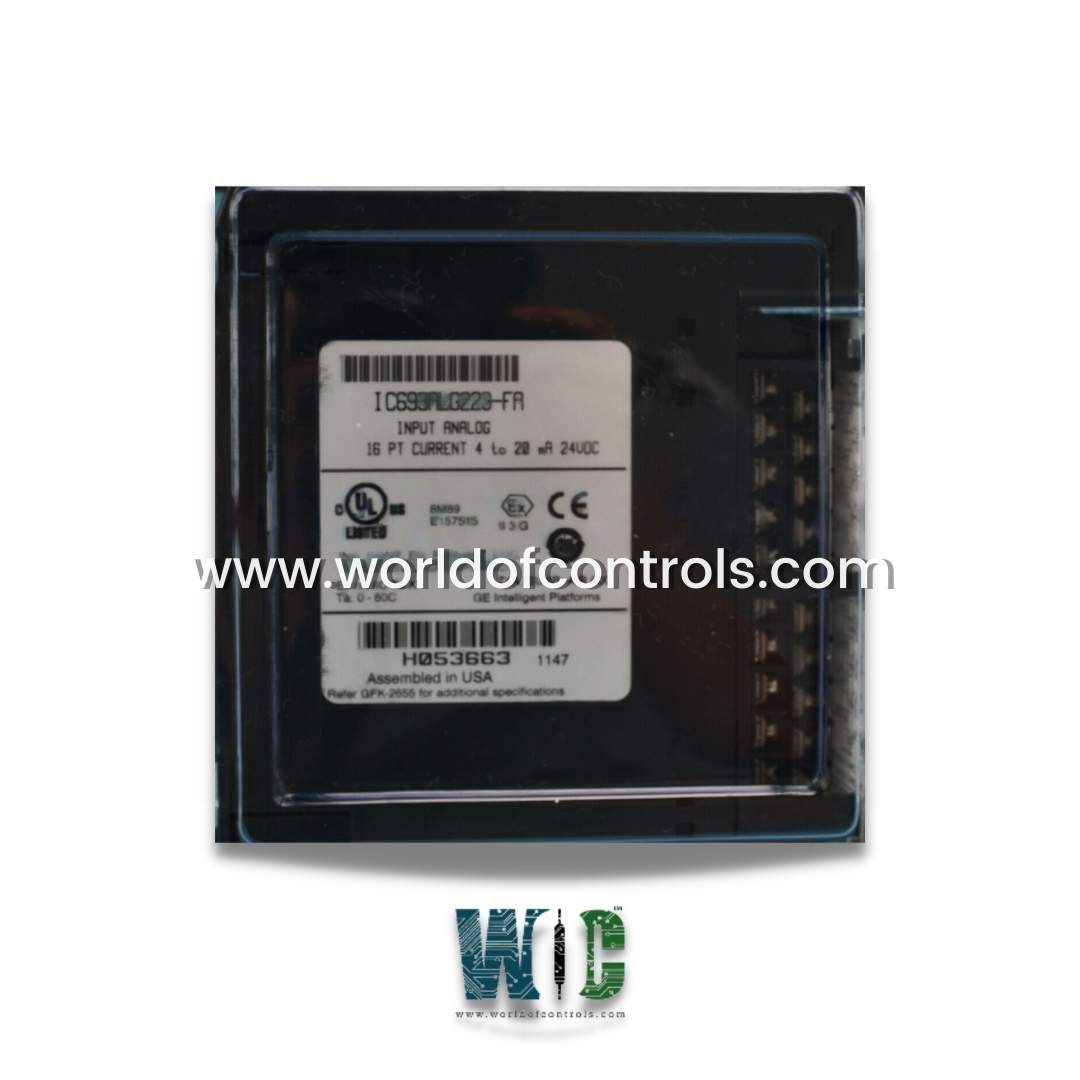
World Of Controls understands the criticality of your requirement and works towards reducing the lead time as much as possible.
IC693ALG223 - 16-Channel Analog Current Input Module is available in stock which ships the same day.
IC693ALG223 - 16-Channel Analog Current Input Module comes in UNUSED as well as REBUILT condition.
To avail our best deals for IC693ALG223 - 16-Channel Analog Current Input Module, contact us and we will get back to you within 24 hours.
SPECIFICATIONS:
Part Number: IC693ALG223
Manufacturer: General Electric
Series: 90-30
Product Type: 16-Channel Analog Current Input Module
Range: 4-20 mA, 0-20 mA
Accuracy: 0.25% at 25 degree Celsius
External Power: 24 VDC
No of Channels: 16
Update Rate: 13 ms all channels
Resolution at 4-20 mA: 4 microamps
Resolution at 0-20 mA: 5 microamps
Input Impedance: 250 ohms
Isolation: 1500 volts
Internal Power Consumption: 120 mA
Availability: In Stock
Country of Origin: United States
FUNCTIONAL DESCRIPTION:
IC693ALG223 is a 16-Channel Analog Current Input Module manufactured and designed by GE Mark II Series as part of the GE Speedtronic Gas Turbine Control Systems. The 16-Channel Analog Current Input module provides up to 16 single-ended input channels, each capable of converting an analog input signal to a digital value for use as required by your application. This module provides three input ranges: 4 to 20 mA 0 to 20 mA 4 to 20 mA Enhanced.
CURRENT RANGES:
The default range is 4 to 20 mA with user data scaled so that 4 mA corresponds to a count of 0 and 20 mA corresponds to a count of 32000. The other ranges are selected by changing the configuration parameters using the IC641 configurator software or the Hand-Held Programmer. The range can be configured so that the input range is 0 to 20 mA with user data scaled so that 0 mA corresponds to a count of 0 and 20 mA corresponds to a count of 32000. Full 12-bit resolution is available over the 4 to 20 and 0 to 20 mA ranges. A 4 to 20 mA Enhanced range can also be selected. When this range is selected, 0 mA corresponds to a count of –8000, 4 mA corresponds to a count of 0 (zero) and 20 mA corresponds to a count of +32000.
The Enhanced range uses the same hardware as the 0 to 20 mA range but automatically provides 4 to 20 mA range scaling with the exception that negative digital values are provided to the user for input current levels between 4 mA and 0 mA. This gives you the capability of selecting a low alarm limit that detects when the input current falls from 4 mA to 0 mA, which provides for open-wire fault detection in 4 to 20 mA applications. High and Low alarm limits are available on all ranges. Ranges can be configured on a per channel basis. The module also reports module status and user-side supply status to the CPU.
POWER REQUIREMENTS AND LEDS:
This module consumes 120 mA from the 5V bus on the PLC backplane and also requires 65 mA plus current loop current(s) from a user-supplied +24V supply (see Table 3-13, Specifications). There are two green LED indicators on the module which provide module and user supply status. The top LED, MODULE OK provides module status information on power-up as follows:
CONFIGURATION:
The 16-Channel Analog Current Input module can be configured using either the Logicmaster 90-30/20/Micro or CIMPLICITY Control Programming Software configurator function, or with the Hand-Held Programmer. The parameters that may be configured are described in the following table. Configuration procedures using Logicmaster 90-30/20/Micro Programming Software and the Hand-Held Programmer are described in the following pages.
WOC has the largest stock of OEM Replacement Parts for GE Speedtronic Control Systems. We can also repair your faulty boards and supply unused and rebuilt boards backed up with a warranty. Our team of experts is available round the clock to support your OEM needs. Our team of experts at WOC is happy to assist you with any of your automation requirements. For pricing and availability on parts and repairs, kindly contact our team by phone or email.
What is a 16-Channel Analog Current Input Module?
A 16-Channel Analog Current Input Module is designed to convert analog signals from up to 16 input channels into digital data. This digital data can then be utilized by industrial control systems for monitoring and managing processes. The module is commonly used in automation systems and gas turbine control systems.
What input ranges does this module support?
It supports three input ranges: 4-20 mA (default), 0-20 mA, and 4-20 mA Enhanced. The Enhanced range provides additional functionality by offering negative digital values for currents below 4 mA, enabling fault detection for open wires in 4-20 mA applications. These ranges are configurable on a per-channel basis, giving flexibility for diverse applications.
What is the resolution of the module?
The module offers a resolution of 4 microamps for the 4-20 mA range and 5 microamps for the 0-20 mA range. This high resolution ensures precise measurement of current signals, making it suitable for sensitive industrial applications.